Top News
January 12, 2012 Ryukyu Shimpo
On January 11, the maiden flight between Naha and Beijing operated by Air China, the most well known of Chinese airline companies, arrived at Naha Airport. The 141 passengers received commemorative gifts and bouquets of flowers in a welcome ceremony held at the international terminal.
To date, direct flights between these two cities have operated only twice a week, and have been provided by Hainan Airlines, but that number has now doubled with the introduction of the new service by Air China. This is the first time for Air China to commence such a service to Okinawa.
At the welcome ceremony, Vice-governor Yoshiyuki Uehara said, “This year is memorable in that it is the 40th anniversary of the normalization of diplomatic relations between Japan and China. I’m very glad that you are visiting Okinawa at such a time, and hope that you create special memories on this trip.”
A young woman from Beijing visiting Okinawa for the first time said with a smile, “Okinawa is surrounded by such beautiful sea. I sort of imagine it as being like Hawaii. I want to go to the Churaumi Aquarium and Kokusai Street.”
The Okinawa Prefecture Government held a welcome reception for the passengers on the evening of January 11 at the Okinawa Harborview Crowne Plaza in Naha.
The service will use 737-800 aircraft that carry up to 162 passengers, and will operate every Wednesday and Saturday. The outgoing flight departs from Naha at 1:30pm and arrives at Beijing on 4:10pm. The incoming flight departs from Beijing at 8:20am and arrives in Naha at 12:30pm local time.
(English translation by T&CT, Lima Tokumori and Mark Ealey)
Go To Japanese
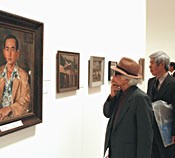
January 12, 2012 Ryukyu Shimpo
An exhibition of the work of an Okinawan artist looking into the essence of beauty called “Pioneer of Okinawan modern sculpture, Seikichi Tamanaha Exhibition – traces of sculptures and paintings” is on at the Okinawa Prefectural Museum & Art Museum in Naha from January 11. Sculptures such as Nozomi no zou, or statue of hope, which has been restored by his students, paintings that have been brought back to Okinawa from the United States, and documents such as diaries and letters are currently being exhibited. The exhibition traces the life work of Seikichi Tamanaha (1918-1984), who introduced modern sculpture to Okinawa in the period after Rodin.
This is the third exhibition of the Okinawan Art series organized by the Prefectural Museum, following on those of Aijun Nadoyama and Seigi Adania. Tamanaha led the way in the Okinawan art world starting the Nishimui Artists Society near the ruins of Shuri Castle in the immediate postwar period. He left behind a body of monuments such as the relief of the Himeyuri Monument. He is also known as an abstract painter who used the decayed wrecks of boats, lamps, and cinerary urns as a motif.
Tamanaha’s oldest daughter, Midori Tamura, gave a speech at the opening ceremony in which she said, “I hope that people viewing his works think about how he felt when he produced these sculptures and paintings. I would like to take another look at my father, a man who loved Okinawa and lived a life dedicated to art.”
Thanks to the cooperation of Stanley Steinberg, who remained in Okinawa during the U.S. military occupation as a medical officer and learnt the basics of painting from Tamanaha, 15 works of art such as oil paintings have been borrowed from the United States. These rare representational paintings of the Nishimui days can be seen in this exhibition.
The exhibition runs through until March 11. Admission charge is 800 yen for adults, 500 yen for high school and university students, 300 yen for elementary and junior high school students.
(English translation by T&CT, Shinako Oyakawa and Mark Ealey)
Go To Japanese
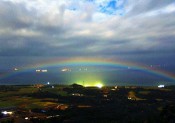
January 12, 2012 Ryukyu Shimpo
In the evening of January 7, a night rainbow was observed at the Ishigakijima Astronomical Observatory. A night rainbow is said to be a phenomenon that invites happiness. It was visible in the western sky looking from the Observatory, which is located at the summit of Mt. Maesedake, and disappeared after about half an hour. This phenomenon looks like a rainbow due to moonlight being refracted by water droplets in the air on the night of a full moon. The colors are paler, and to the naked eye it looks white.
In Hawaii it is called a moonbow or night rainbow, and is said to bring happiness or to make a wish come true. In China imagery around rainbows is linked to dragons.
(English translation by T&CT, Mark Ealey)
Go To Japanese
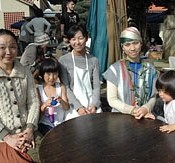
January 10, 2012 Ryukyu Shimpo
On January 11, ten months had passed since the Great East Japan Earthquake. Japanese singer-songwriter UA, who moved from Kanagawa Prefecture to Okinawa because of the Fukushima Daiichi nuclear disaster, and her friends who also evacuated to Okinawa, established Tida no wa, an organization to consider safety issues related to internal radiation exposure through food consumption. They plan to hold the Tida no wa Festival, which includes live performances and lectures delivered by experts, at the 21st Century Forest Park in Nago on the weekend of March 10 and 11. A representative of the organization stated, “It is possible that radiation-contaminated food products could appear in markets as far away as Okinawa. What we need is information and knowledge, rather than just fuelling people’s fears of radiation contamination.”
Concerned about the potential impact of radioactive fallout on her children, last April UA moved to the northern part of Okinawa’s main island. Her mother is from the Amami Islands so she has an affinity with Okinawa and its distinctive energy. She came up with the idea of holding a festival when thinking about what she might be able to do to help protect Okinawa.
Tida no wa was established on November 11, 2011 as an organization to host festivals and to create a network of parents who would look into food-safety issues. On January 8, the organization promoted the Tida no wa Festival in Tsunagu Omoi, or Connected Memories, an event held at Futenmanzan Jinguji Temple to support earthquake refugees. Profits from the event were donated to Tida no wa.
The objective of the organization is to expand exchange to encompass not only to the people who have taken refuge from other prefectures, but also local people. UA said, “I would like to tell our beloved neighbors about the things I’ve learned.” She is always striving to get as many people as possible on the same wavelength.
Kiko Nemoto, a member of the organization who has been active as a food coordinator, said, “The Radiation Protection Standard specified by the government is unclear. Some of the food products from Fukushima Prefecture are definitely safe. We all want to look into this carefully, and not merely fuel fears of radiation contamination.”
The Tida no wa Festival includes live performances by UA and husband and wife duo Aimoko, and a lecture by Katsuma Yazaki, professor emeritus at University of the Ryukyus on internal exposure to radiation.
For further details, access the blog of Tida no wa at http://tidanowa.ti-da.net/ or call Ueda of Tida no wa Festival Executive Office at 050 (1576) 1117.
(English translation by T&CT, Mark Ealey)
Go To Japanese
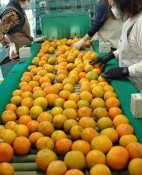
January 11, 2012 Ryukyu Shimpo
On January 10, a ceremony marking this season’s first shipment of the citrus tankan Hayata was held at the Northern District Farming and Promotion Center of JA (Japan Agricultural Co-operatives) Okinawa, in Isagawa, Nago. About 100 participants, including producers and JA members, dispatched the tankan, which are known as an Okinawan taste of winter, to locations throughout the country. The impact of the typhoons last May and August mean that this year’s total shipping volume is expected to be just 239 tons, the lowest to date. According to the JA, this season’s tankans are characterized by their strong acidity, but sweetness and relatively large beads. Shipments will continue until mid-February.
As of November 28, the JA estimated that the production volume of tankan for fiscal 2011, 2011 will be 197 tons of fruit and 42 tons of processed product. This year’s fruit volume will be 32 percent of the previous fiscal year’s production volume in that production has fallen to 65 percent of that of the previous year. The total shipment volume is expected to remain at 35 percent of that of the previous year and the price for tankan will rise slightly.
At the shipment ceremony, on behalf of farm producers, Tamotsu Matsuda, the chief of the northern district office of JA Okinawa and Muneo Gakiya said some words of greetings. Gakiya speculated that it would take several years to recover from the typhoon damage and stressed the need for countermeasures to be put in place. He went on to say, “As producers, we would like to deliver tankans that the consumer that taste great, and are thoroughly safe to eat.”
(English translation by T&CT, Mark Ealey)
Go To Japanese
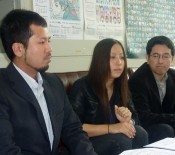
January 11, 2012 Ryukyu Shimpo
On January 10, Minami Tamamoto, the director of the Okinawa head office of the World Youth Uchinanchu Association and others held a press conference and announced that three Okinawan young people including director Tamamoto join the 5th Niiseetaa Tour to Brazil. The 5th World Wide Uchinanchu Festival in October 2011 led to the establishment of the Association and this is the first time that Okinawan young people will take part in the tour.
The Niiseetaa Tour was started in 2007 to provide an opportunity for interaction between young Okinawan in South America and this year is the fifth time the tour has been held. About 60 Okinawan young people from eight countries including Japan will participate in the tour. Representatives from Okinawa or Japan, and United States, will be taking part for the first time.
Tamamoto will introduce Okinawan geography and culture using power point displays and Kuganikutuba, or the Okinawan proverb using an original picture-story show. During the tour, young Okinawans will meet to discuss the planning and organization of the 1st Okinawan Youth Festival due to be held in Brazil in July. Tamamoto said, “I look forward to visiting Brazil and communicating with young Okinawans in South America. I would like to find out what roles young Uchinanchu in Okinawa can play and the meaning of our office in connecting the world with Okinawa.”
The office is raising funds in order to dispatch the three people (900,000 yen) including the international airfare. Information for those wishing to make donations is given below.
Bank of the Ryukyus Ginowan branch checking account 575799, account holder’s name is Sekai wakamono uchinanchu rengoukai Okinawa honbu.
For further information please call 080-4363-9047 (Tamamoto).
(English translation by T&CT, Shinako Oyakawa and Mark Ealey)
Go To Japanese
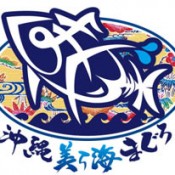
January 5, 2012 Ryukyu Shimpo
On January 4, at Tomari Fish Market, the Fresh Fish Wholesalers and Distribution Cooperative of Okinawa announced the logo for Okinawa Churaumi tuna, ocean-fresh fish. This is a part of the Okinawa Churaumi tuna branding project. Kiyoshi Toyama, the director of the Cooperative said, “We would like to make use of the logo to promote Okinawan tuna, and want to further expand our market outside the prefecture.”
The four major types of tuna caught in the seas around Okinawa are the bluefin, bigeye, yellowfin and albacore tuna and they account for the highest number of fish caught around Okinawa. Okinawa recorded the third highest number of tuna caught in the nation during fiscal 2009.
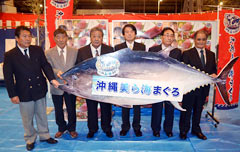
On January 4, people involved in the fish market at Tomari, Naha, publicize the logo of Okinawa Churaumi tuna.
The brand standard for Okinawa Churaumi Tuna set by the market is for tuna caught in the coastal waters of Okinawa or further south, and fresh tuna (natural or not frozen tuna), with fishing methods including longline and pole‐and‐line fishing from the floating fish reef called Payao.
The logo was created by Asae Miyagi, a student at IT College Okinawa. Her work was chosen from among about 50 works submitted by the public last October.
(English translation by T&CT, Mark Ealey)
Go To Japanese
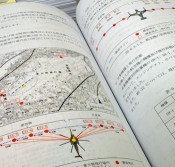
January 8, 2012 Ryukyu Shimpo
On January 7, the full text of the written evaluation of the environmental impact of the reclamation of the coastal area of Henoko in Nago, which the Okinawa Defense Bureau has submitted to Okinawa Prefectural Government (OPG), was revealed. With regard to the deployment of the MV-22 Osprey vertical take-off and landing transport aircraft to the Futenma Replacement Facility, something which is mentioned for the first time, the environmental impact report estimates that low-frequency sounds generated by the Osprey could possibly affect the people living in Abu Village of Nago both on a psychological and physiological level. It is pointed out that these sounds could cause health hazards such as the disturbance of sleep and that they could possibly have a physical impact, such as in the form of building vibration in the ten spots that were surveyed, including the Okinawa National College of Technology. With regard to the Weighted Equivalent Continuous Perceived Noise Level (WECPNL), the report estimates higher values at all 14 spots surveyed than predicted in the report’s preparatory documents, which indicates that the noise caused by the Osprey would clearly have a negative impact on the living environment. The Ryukyu Shimpo newspaper was able to procure the full text of the report by January 7.
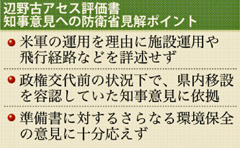
In the Henoko environmental impact report, the Ministry of Defense presented its viewpoint in response to Okinawa Governor Hirokazu Nakaima’s statements of opinion.
With regard to aircraft noise levels, the report estimates a WECPNL of over 70, the standard value, which is specified by environmental quality standards for noise, in Camp Schwab and part of the Toyohara coastal area of Nago. However, the report claimed, “There are no villages in the regions with a WECPNL of over 70.”
On the other hand, the report does not clearly deny that flight paths would go over residential areas, stating, “Basically is it preferable to avoid flight paths over residential areas.” The report also states that if the U.S. military has “operational reasons” not to, aircraft do not need to follow the elliptical traffic pattern. The report does not include flight paths to other military bases in Okinawa such as the new helipads at Takae in Higashi Village in the U.S. Northern Training Area. It is possible that the noise level at the village area could actually be higher than the estimates.
Although the central government did present its views in response to Okinawa Governor Hirokazu Nakaima’s opinion of the preparatory documents of the environmental impact report, on this occasion more than 20 of the governor’s questions regarding his stance were unanswered.
It is also revealed that the operation of aircraft at the Futenma Replacement Facility is expected to cause radio disturbance. According to a survey conducted by the Nago municipal authorities and Ginoza Village, there is already interference to terrestrial digital television in these locations and it is predicted that flights by U.S. military aircraft could see the situation deteriorate even further. The report suggests that “Maximum avoidance measures possible to reduce the environmental impact could be adopted.”
The report indicates that the construction of the Futenma Replacement Facility could wipe out seaweed species on the total of 68.3 hectares and seagrass beds on the total of 78.1 hectares (degree of coverage more than five percent). The preparatory documents of the report stated that to avoid this situation and reduce the impact, the central government would implement countermeasures to expand the inhabitation range for seagrass beds in the surrounding areas. The governor doubted the viability of such countermeasures and requested the central government to review them and do a reevaluation. However, the Bureau dismissed this request, stating, “Within the bounds of possibility, maximum avoidance and reduction will be adopted.”
Until January 6, the Bureau submitted to OPG three parts of “the written evaluation on the environmental impact of the reclamation of the coastal area of Henoko, Nago for the construction of replacement facilities for the United States Marine Corps Air Station (USMCAS) Futenma,” the abstract and appendix, reference data (surveyed from fiscal 2009 to 2010) plus the additional report and its abstract.
Terminology: Environmental Impact Statement
In the case of large construction projects, the business operator (the central government) is required by law to investigate, predict and evaluate the environmental impact of related business procedures and to submit a report on this to the relevant prefectural and city governments as the final stage in the process. The governor must then return a written statement of opinion within 90 days of having received the evaluation report from the business operator in the case of reclamation projects based on law, and within 45 days for airport construction projects based on Prefectural Ordinance. The central government then makes amendments based on that written statement of opinion, and with this, the evaluation assessment is complete. The business operator (the central government) can then apply for approval from the governor for the construction landfill.
(English translation by T&CT, Mark Ealey)
Go To Japanese
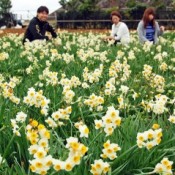
January 8, 2012 Yukito Kinjo correspondent of Ryukyu Shimpo
Narcissus flowers are in bloom and brighten up the day of the villagers in 64 year-old Toshikazu Uchima’s Narcissus Gardens in Ie Island.
The gardens are located near Iejima Airport in Nishieue Ie Village, by the natural source of freshwater called Wajii on the northern coast. The flowers bloom from the end of December and their petals sway in the wind as though they are dancing. The narcissus has white petals and a yellow heart, and has a sweet scent.
Besides running Pharmacy Uchima, 30 years ago he started to plant narcissus flowers in attempt to create an island full of beautiful flowers. Uchima said, “I want people to enjoy the flowers in bloom and their lovely scent.”
The narcissus flowers look fantastic right through the month of January. For a fee, the garden will pick flowers for customers. For further information please contact Pharmacy Uchima at 0980-49-2123.
(English translation by T&CT, Shinako Oyakawa and Mark Ealey)
Go To Japanese
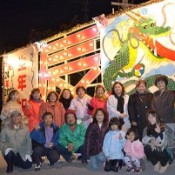
January 7, 2011 Tsubaki Mekaru of the Ryukyu Shimpo
At two separate locations in Henza Island, to commemorate the zodiac sign of the old Chinese calendar, and the year in which they turn 60 years of age, about 20 volunteers of the 20th graduating class of Henza Junior High School of Yonagusuku in Uruma created an illuminated letter in the shape of the Chinese character for dragon, this year’s sign of the zodiac. The lights symbolize the desire to revitalize Henza Island through the activities of people born in the Year of the Dragon.
The idea of making an illuminated character was started by members born in the Year of the Hare, who turned 60 years of age in 2011. Last year it was set up at only one location, by the road to the highland disaster prevention area, but this year’s group further developed the idea to two locations.
Yoshihiro Matsuda painted the picture of a dynamic looking dragon for the illuminated character, which is about 3.5 meters (11 feet 5 inches) high and about 7.2 meters (23 feet 7 inches) wide in front of the community hall. He has had a talent for drawing since he was in elementary school, and said, “I hope that people who see this enjoy it.” It took about two weeks to do and Matsuda took time off his job to complete the picture. One of the group who lives in Nishihara brought the wire for the illumination, and the former classmates all worked together to finish it. Masanobu Agena, a member of the volunteer group, said, “I hope that the lights help to make everyone on the island happy.”
The illuminated letter will be in place until the joint-celebration for people born in the Year of the Dragon, which is scheduled to be held on February 1 in the Community Hall. Tamami Yamashiro and Kiyomi Shimojo said, “Some of our old classmates cannot be contacted because they have moved. Classmates who grew up on the island are like brothers and sisters, so we hope that everyone can make it to the celebration.” For further information regarding the celebration contact the Henza Community Hall. Telephone:098 (977) 8127.
(English translation by T&CT, Lima Tokumori and Mark Ealey)
Go To Japanese
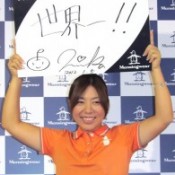
January 6, 2012 Ryukyu Shimpo
On January 5 at a press conference in Tokyo, female professional golfer Mika Miyazato announced her new contract with a sportswear manufacture DESCENTE and shared her New Year’s resolution for 2012. Miyazato stated that she would fly to the United States that evening for her fourth tilt at success on the U.S. Tour, and with a steely determination in her voice she stated that her New Year’s resolution was “to become the best in the world.”
She ranked in the top ten in three of golf’s four major championships last season, but only ranking 22nd on the money list, meaning that she did not achieve her goal of making the top ten, something which Miyazato describes as “a disappointing result.”
In the U.S. Women’s Open Championship in July she put in an impressive effort, coming fifth. “It gave me confidence and got me closer to my dream.” While she was the solo leader at one point, she missed out on her first victory of the tour. “I was very frustrated. It is difficult to express the feeling in words… The season ended so quickly after that.”
The issue is her short game near the green. Improvement in her putting and strengthening her lower body with the focus on the right leg are also key points. Including mental training, she has worked on various aspects of her game with a number of coaches.
She aims to put pressure on herself by setting the high goal of becoming “the best in the world” in all respects such as on the money list and the world’s players’ ranking list. She has been pushed to work even harder by the success of her rival since junior golf, the prize money queen of the U.S. Tour Yani Tseng from Taiwan, who was the MVP for two consecutive years.
During the year-end and New Year holidays, Miyazato spent time with old friends and had a break. At the press conference, having renewed the contract with the Munsingwear brand that she has had since childhood, she stated, “I want to win wearing my favorite orange color clothing.”
(English translation by T&CT, Megumi Chibana and Mark Ealey)
Go To Japanese












 Webcam(Kokusai Street)
Webcam(Kokusai Street)


